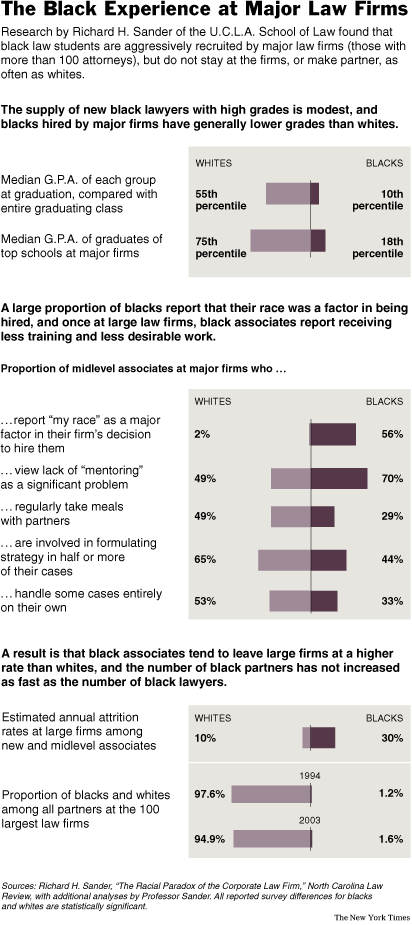| Want to send this page or a link to a friend? Click on mail at the top of this window. |
More Special Reports |
| Posted November 29, 2006 |
Lawyers Debate Why Blacks Lag At Major Firms |
|
 |
|
Monica Almeida/The New York Times |
|
| Richard H. Sander, a U.C.L.A. law professor, is the author of a recent study on diversity efforts at corporate law firms that has stirred debate. |
_____________ |
|
By ADAM LIPTAK |
THANKS to vigorous recruiting and pressure from corporate clients, black lawyers are well represented now among new associates at the nation’s most prestigious law firms. But they remain far less likely to stay at the firms or to make partner than their white counterparts.
A recent study says grades help explain the gap. To ensure diversity among new associates, the study found, elite law firms hire minority lawyers with, on average, much lower grades than white ones. That may, the study says, set them up to fail.
The study, which was prepared by Richard H. Sander, a law professor at the University of California, Los Angeles, and was published in The North Carolina Law Review in July, has given rise to fierce and growing criticism in law review articles and in the legal press. In an opinion article in The National Law Journal this month, for instance, R. Bruce McClean, the chairman of Akin Gump Strauss Hauer & Feld, a major law firm, took issue with the study’s “sweeping conclusions” but not its “detailed data analysis.”
James E. Coleman Jr., the first black lawyer to make partner at Wilmer Cutler & Pickering, a prestigious Washington law firm now known as WilmerHale, said Professor Sander was overemphasizing grades at the expense of other qualities like writing skills, temperament and the ability to analyze complex problems.
“I don’t think you can do what he is trying to do, which is to use purely objective data to explain what is happening in law firms,” said Professor Coleman, who now teaches law at Duke and is a co-author of a response to Professor Sander called “Is It Really All About the Grades?”
Achieving racial diversity at all levels is an urgent issue, law firms say, but they acknowledge that gains among new associates disappear by the time new partners are elected. “We’ve seen stagnation and even decline when it comes to race,” said Meredith Moore, the director of the New York City Bar Association’s diversity office.
The new study proposes an explanation. It found that the pool of black lawyers with excellent law-school grades is so small that firms must relax their standards if they are to have new associates who resemble the pool of new lawyers.
Professor Sander found that very few blacks graduated from top-30 law schools with high grades.
Yet grades, according to many hiring partners and law students, are a significant criterion in hiring decisions, rivaled only by the prestige of the law school in question. For instance, Professor Sander found, “white law school graduates with G.P.A.’s of 3.5 or higher are nearly 20 times as likely to be working for a large law firm as are white graduates with G.P.A.’s of 3.0 or lower.”
The story for black students appears to be different. Black students, who make up 1 to 2 percent of students with high grades (meaning a grade point average in the top half of the class) make up 8 percent of corporate law firm hires, Professor Sander found. “Blacks are far more likely to be working at large firms than are other new lawyers with similar credentials,” he said.
But black lawyers, the study found, are about one-fourth as likely to make partner as white lawyers from the same entering class of associates.
Professor Coleman attributed that largely to law firms’ failure to provide minority associates with mentoring, encouragement and good assignments. “It’s such a high-pressure place that places so much emphasis on getting it right that a young associate easily loses confidence,” he said. “But to succeed you have to take risks.”
No one disputes that firms are failing to retain and promote most of the minority lawyers they hired, at salaries that can start at $135,000.
“Black and Hispanic attrition at corporate firms is devastatingly high,” Professor Sander wrote, “with blacks from their first year onwards leaving firms at two to three times the rate of whites. By the time partnership decisions roll around, black and Hispanic pools at corporate firms are tiny.”
Less prestigious firms are much less likely to hire minority lawyers with substantially lower grades than white lawyers, Professor Sander said in an interview.
 |
“Black associates report experiences at small firms — in mentoring, job responsibility and contact with partners — that are generally indistinguishable from the experiences reported by white associates,” Professor Sander said. Those experiences suggest that minority lawyers at small firms have a good shot at partnership, but Professor Sander said he did not have direct evidence on that point.
Critics generally concede the raw numbers. But they offer different reasons for the gap between hiring and promotion. Some point to old-fashioned racism. Others say that firms act institutionally in hiring but leave work assignments to individual partners. Those partners often provide poor training, rote assignments and little mentoring to minority lawyers.
That should be unsurprising given the credentials gap, said Roger Clegg, president of the Center for Equal Opportunity, which opposes hiring preferences based on race. “If everyone in the law firms knows you’re hiring according to a double standard, you actually may end up compromising the confidence that partners and others have in the ability of people hired on the basis of preference,” Mr. Clegg added. “It actually reinforces stereotypes.”
The experience of white female associates provides a series of contrasts. Women at large firms have slightly better grades than men, yet they are also underrepresented in classes of new partners. But women do not report the absence of mentoring and choice assignments that minority associates do.
“Strikingly, women’s self-reported work experiences — in terms of mentoring, level of responsibility and access to partners — are positive and indistinguishable from the self-reports of white men,” Professor Sander said. “Consistent with this picture, white women’s attrition rates as entering and midlevel associates are nearly as low as those of white men.”
Associates typically work for about eight years before being considered for partnership. “As women of all races approach the seventh year of their tenure, and contemplate the compatibility of big-firm partnership with their family and quality-of-life goals,” Professor Sander said, “many women pull out of the running for partners and seek out less demanding jobs.”
Though many supporters of affirmative action question Professor Sander’s conclusions, most academic experts say his empirical work is sound.
“He makes a good case,” said Kenneth G. Dau-Schmidt, an authority on the economic analysis of legal problems at the Indiana University School of Law. “What the data tells him is that there’s a mismatch going on and it’s hurting black students.”
____________ |
|
| Lower grades are cited as a factor in the racial gap between hiring and promotion. | |
____________ |
In their response to the Sander study, Professor Coleman and Mitu Gulati, another law professor at Duke, wrote that the Sander paper would aggravate the problem it described.
“The harm of the Sander article,” the two professors wrote, “is that it will contribute to the stereotyping that already undermines the success of black associates in elite corporate law firms.”
Stephen F. Hanlon, a partner with Holland & Knight, a national law firm, said the Sander study overlooked a positive reason for high attrition rates among minority lawyers. Female and minority lawyers, he said, are often hired away from law firms by corporate law departments, and that will have an impact over time.
“We have trained a very bright generation of women and minority lawyers who have gone to our corporate clients and who now decide whether to hire us,” Mr. Hanlon said.
Supporters of affirmative action acknowledge that trend, and add that high rates of minority attrition should be unsurprising given the grinding, mercenary culture of most law firms.
“Minorities, when they look at management structures and see that so few make it, they probably give up,” said Veta T. Richardson, the executive director of the Minority Corporate Counsel Association.
Even Professor Sander’s critics say he has started an important discussion.
“We have done our share of stone throwing,” Professor Coleman and Professor Gulati wrote in their response, “but that should not take away from the fact that Professor Sander has identified a real problem that needs serious study, and that his study has added considerably to the limited body of available, public research, even though his conclusions are, at best, premature.”
Copyright 2006 The New York Times Company. Reprinted from The New York Times, National, of Wednesday, November 29, 2006.
RELATED ARTICLE: Still Left Behind
| Wehaitians.com, the scholarly journal of democracy and human rights |
| More from wehaitians.com |